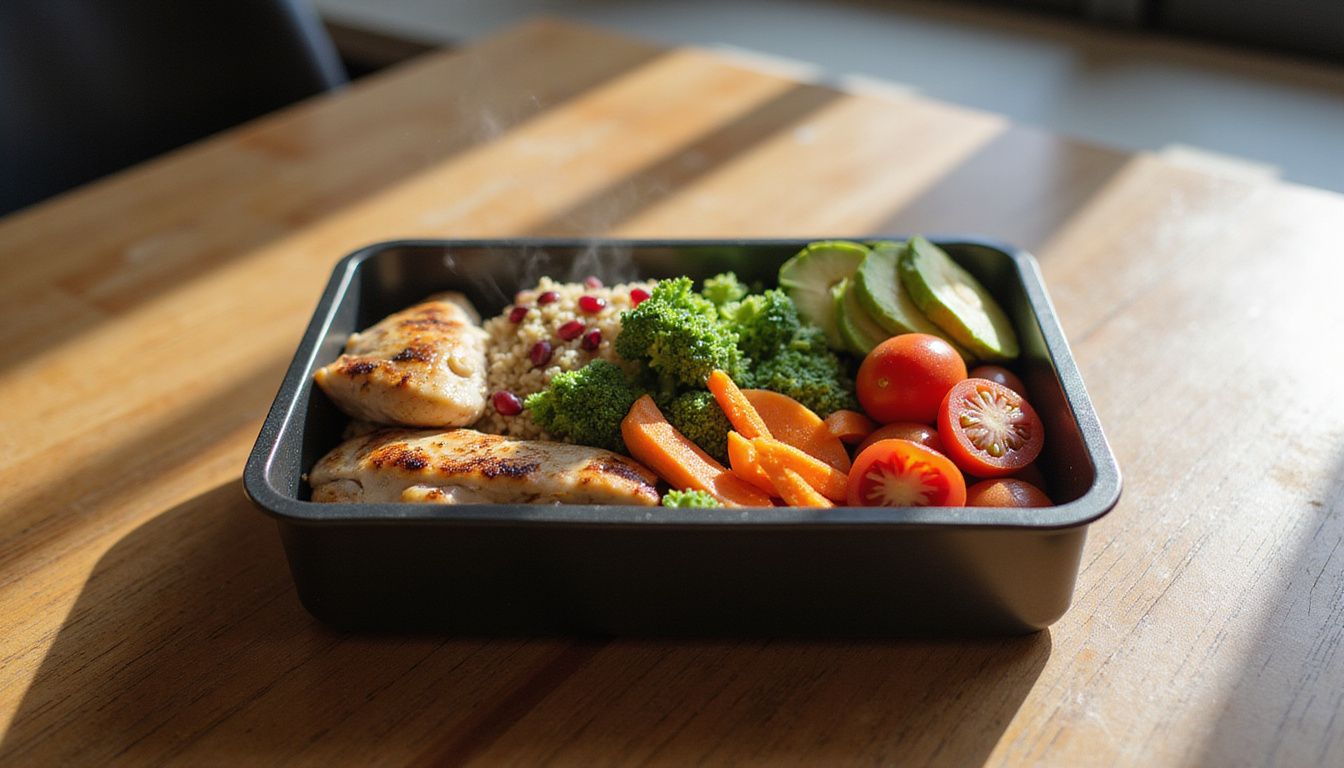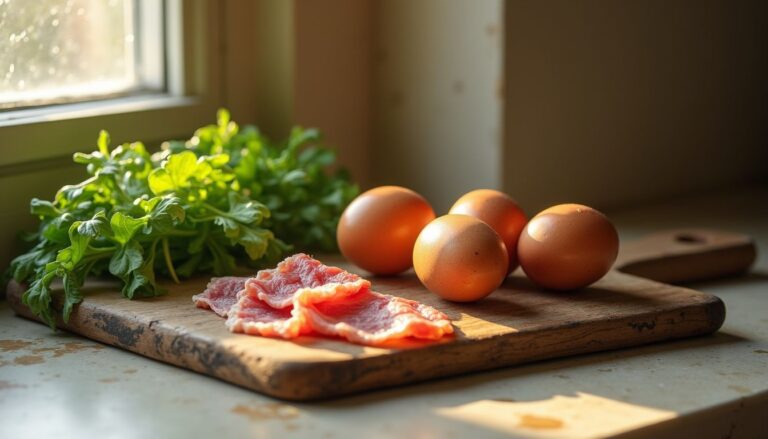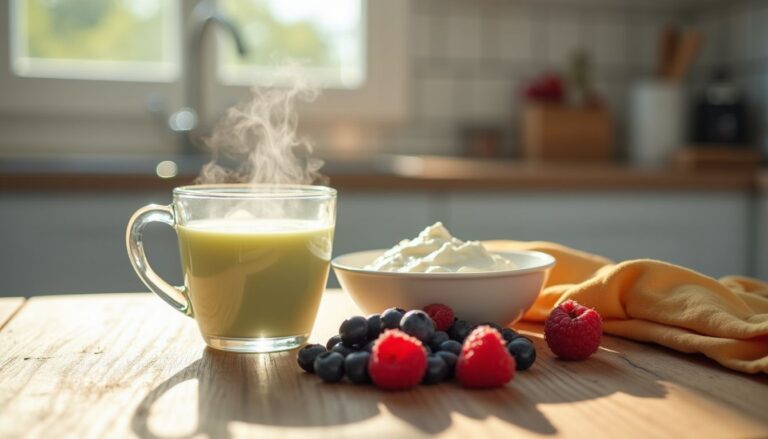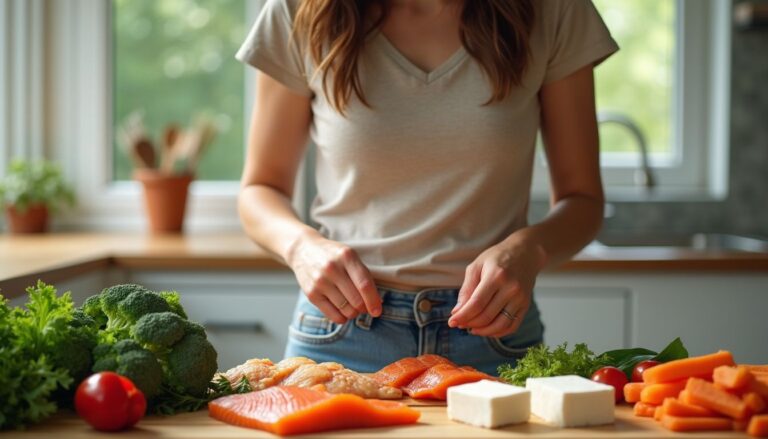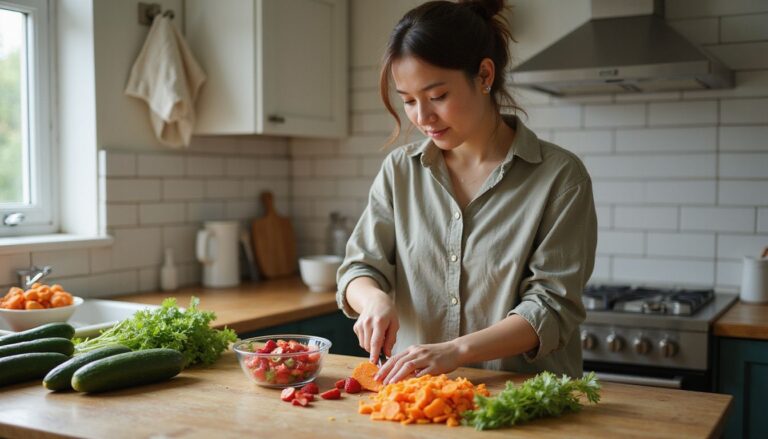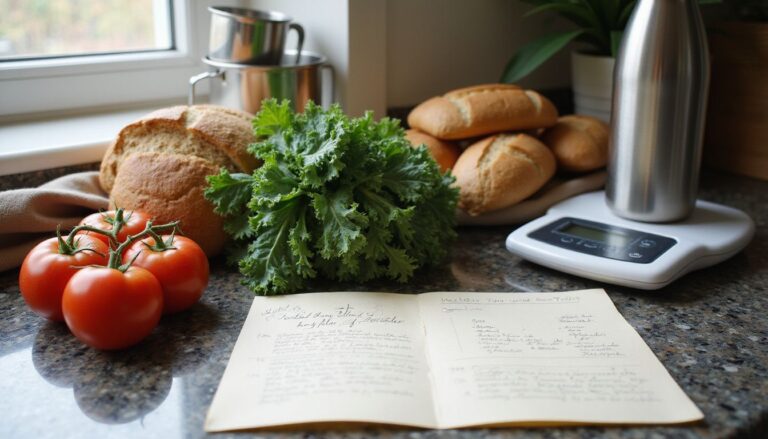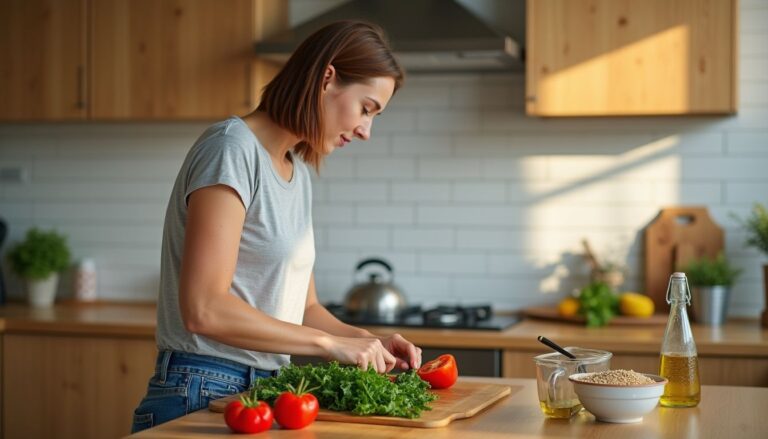Delicious Healthy Lunches For Weight Loss: Expert Recipes And Ideas
Our Nutrition Assistant AI Suite will transform your body. You will lose fat, get toned, and build muscle. Gain confidence and optimal health.
You may struggle to find healthy lunches for weight loss that taste great and keep you full. Experts agree that lunches high in protein and fiber help you stay satisfied and support weight management.
Here, you will find easy lunch recipes, practical tips from registered dietitians, and nutrition details to guide your choices. See which simple ideas can refresh your midday routine and fit your goals. This guide is educational only. For personal advice, speak with your healthcare provider or a registered dietitian.
Key Takeaways
- High-protein, high-fiber lunches, such as Mason Jar Power Salads with 26 g protein and 8 g fiber, improve fullness and support progress.
- Dietitians suggest filling at least half your plate with vegetables. Aim for 25 to 38 grams of daily fiber for digestion and satiety.
- Meal prep picks like Curried Chicken Bowls or Stuffed Sweet Potatoes make healthy eating easier. Many bowls stay fresh up to four days in the fridge.
- Many low-calorie lunch recipes, often under 400 calories per serving, use lean proteins like chicken or tofu plus whole grains for steady energy.
- Choosing whole foods, for example salads or wraps with fresh produce, helps limit added sugars and refined snacks, which often trigger cravings.
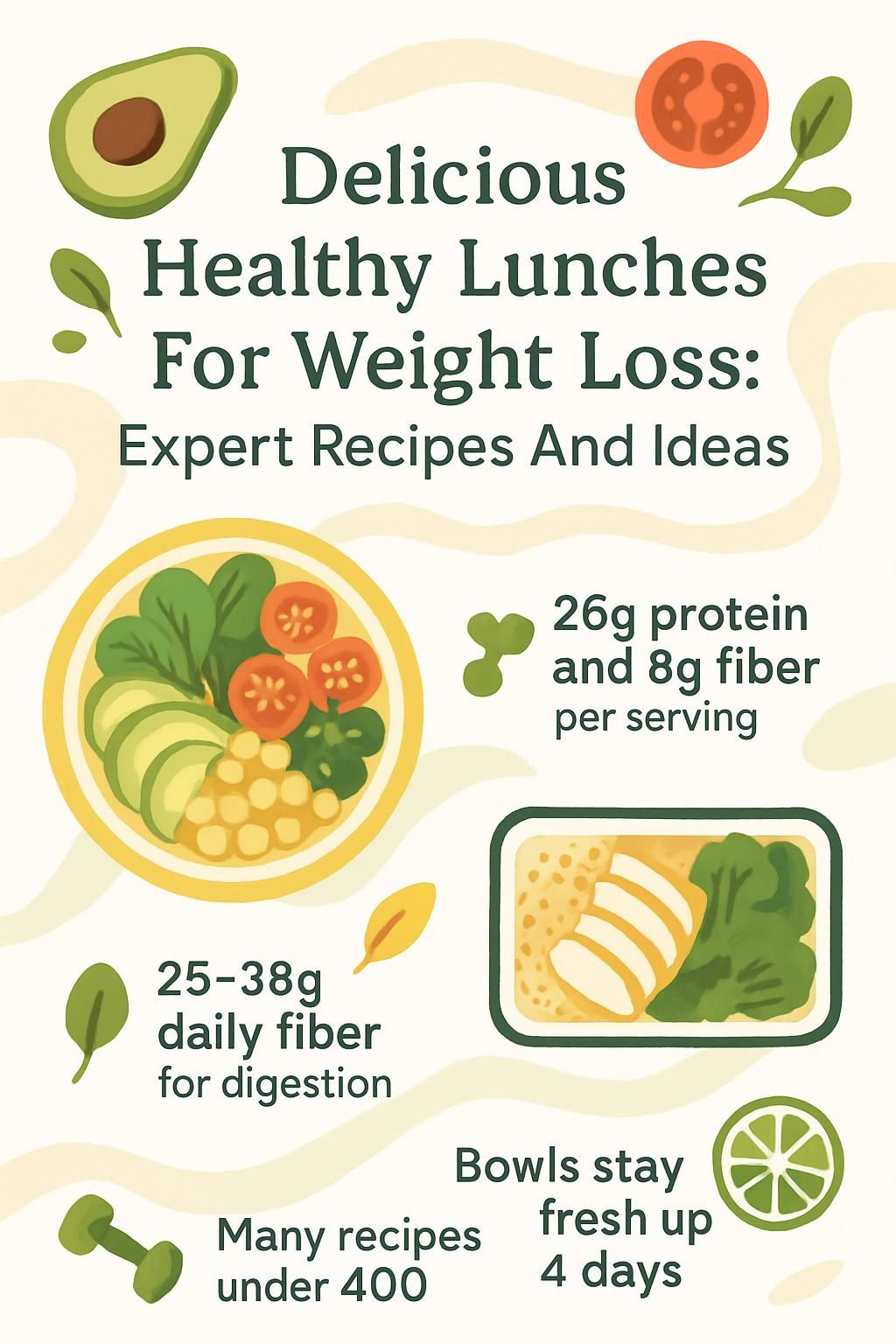
Why Are Healthy Lunches Important for Weight Loss?
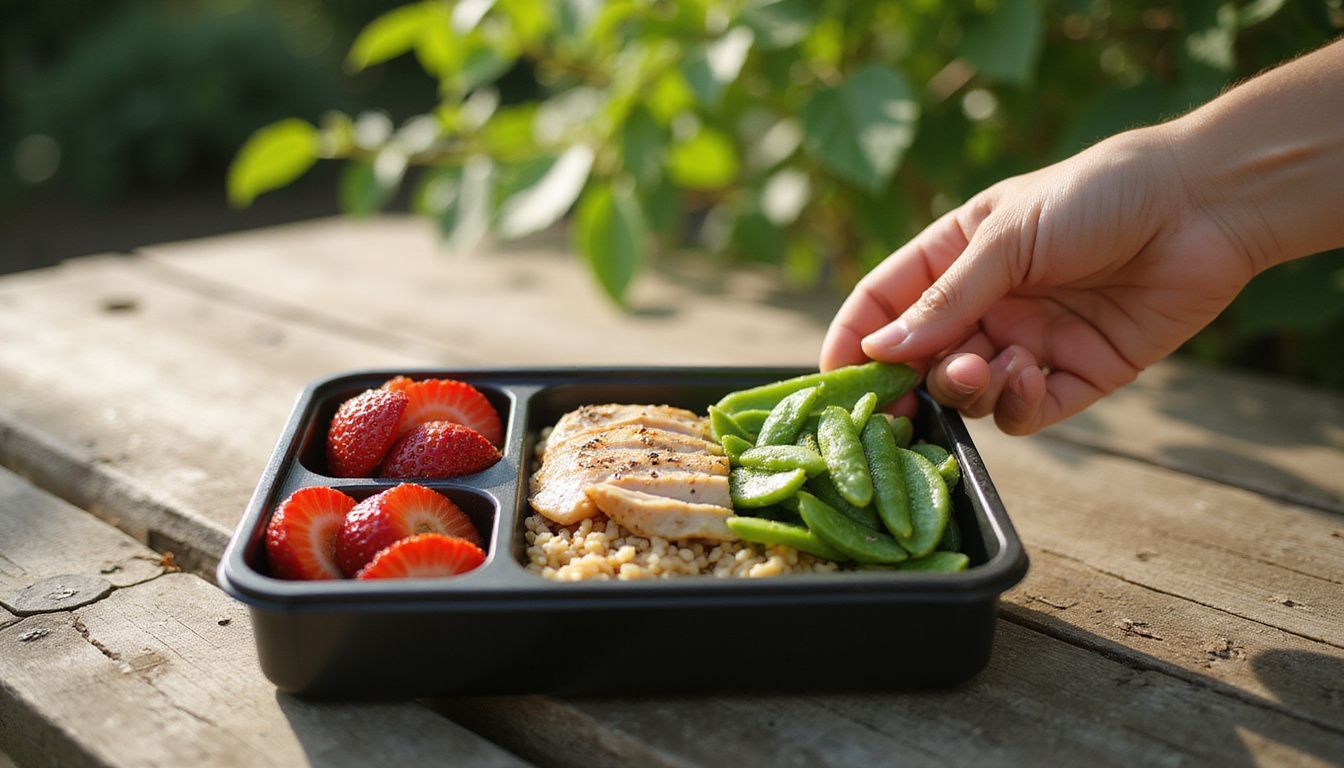
Healthy lunch ideas make weight loss easier because they control calories and keep you energized. Think of lunch as the fuel stop that carries you through the afternoon without a crash.
How Do Nutrient-Dense Meals Fuel Your Body?
Nutrient-dense meals deliver protein, fiber, vitamins, and healthy fats that steady blood sugar and mood. A lunch with chickpeas and quinoa adds plant protein and complex carbs, plus minerals like iron and magnesium to help you feel full longer.
Research links lunches rich in lean proteins, such as chicken or tofu, and plenty of vegetables with better satiety and weight control. Whole grains like brown rice or whole wheat bread add dietary fiber, which supports digestion and fullness.
These balanced choices help prevent afternoon slumps, so you skip impulse snacks. Strong nutrition at midday also supports muscle repair and cell protection thanks to antioxidants in vegetables like spinach and broccoli.
How Do Healthy Lunches Promote Sustainable Weight Management?
Once you see how nutrients power your day, the weight benefits are clear. High-protein and high-fiber lunches reduce hunger, stabilize energy, and help you stick to a calorie target.
Protein-packed meals can cut afternoon cravings and reduce overeating later. A simple chickpea salad or a turkey wrap offers solid protein without many extra calories.
Vegetables, whole grains, chicken, and legumes like lentils bring volume and nutrition per bite. Many expert-approved recipes stay under 400 calories per serving yet still feel hearty. Prepped meals, like mason jar salads or sweet potato bowls, make healthy eating automatic during busy weeks.
How Can Healthy Lunches Keep You Full and Reduce Cravings?
Protein, fiber, and healthy fats slow digestion and reduce hunger signals. A Mason Jar Power Salad with chickpeas and tuna delivers 26 g protein and 8 g fiber per serving, which helps you stay full through the afternoon.
Add hummus, tofu, or black beans to increase satiety. A cup of Super Green Soup with Parmesan crisps can provide around 25 g protein without excess calories.
One reader shared,
Swapping my usual sandwich for a high-protein chicken salad stopped my mid-afternoon snack attacks.
Use toppings like avocado or roasted vegetables for extra fiber and texture. Feeling satisfied after lunch makes it easier to eat a moderate dinner.
Expert Tips for Crafting Healthy Lunches
Healthy lunches shine when you combine lean protein with plenty of fiber. Use these evidence-based strategies to build meals that satisfy, travel well, and support your goals.
Why Focus on Lean Protein and Whole Grains?
Lean protein keeps you full and supports muscle. Whole grains add fiber for steady energy and better digestion. Choose chicken breast, tofu, salmon, tuna, or Greek yogurt for protein. Pair with farro, quinoa, brown rice, whole wheat wraps, or pitas for fiber.
A Grilled Chicken and Pineapple Sandwich has about 387 calories and pairs lean chicken with whole grains for lasting energy. Dietitian Jessica Ball recommends mixing protein and grains with vegetables to reduce cravings. The Chicken, Quinoa & Veggie Bowl offers 19 g protein per serving for reliable fullness.
Leftovers help too. Try cooked salmon or a baked potato sliced into a whole grain wrap for a fast lunch to go.
How Much Vegetables and Fiber Should You Include?
Fill at least half your plate with vegetables. This raises fiber, vitamins, and minerals while keeping calories low. Most adults need 25 to 38 grams of fiber daily.
To reach your target, roast vegetables for salads, or toss shredded Brussels sprouts and crispy chickpeas into a bowl. Build a high-fiber Mediterranean mix with chickpeas, cucumber, bell pepper, red onion, olives, avocado, feta, and herbs.
Harvest Vegetable Soup offers big nutrition with about 15 minutes of prep. Freeze portions for up to three months. Swap in zucchini noodles or cauliflower rice for extra volume with fewer refined carbs. Fiber-rich foods support steady energy and better digestion all afternoon.
How Can You Limit Processed Foods and Added Sugars?
Choose whole foods like kale, tomatoes, and spinach. Replace packaged lunches with simple recipes such as Chopped Salad with Sriracha Tofu & Peanut Dressing or Couscous & Chickpea Salad. Fresh ingredients keep additives low.
Roast a tray of vegetables and use them in quinoa bowls or wraps. Skip sugary sauces. Make a quick vinaigrette or use hummus as a creamy, low-sugar dressing.
I prepped a week of lunches with roasted vegetables and canned chickpeas. My energy stayed steady, and I did not crave sweets. These habits help you boost fiber and cut added sugar at the same time.
Quick and Easy 5-Ingredient Lunches
Short on time? These 5-ingredient lunch recipes deliver flavor, lean protein, and vegetables. They are light, fast, and fit a busy day.
What Is an English Muffin Pizza with Tomato & Olives?
An English Muffin Pizza with Tomato & Olives is a tasty lunch you can assemble in under 15 minutes. You need only five simple ingredients.
- Use whole grain English muffins for extra fiber that supports fullness and weight goals.
- Top each half with fresh tomato slices for vitamin C and antioxidants like lycopene.
- Add a small amount of part-skim mozzarella to limit saturated fat.
- Layer on black olives for heart-healthy fats and a savory boost.
- Season with dried oregano for flavor without extra calories or sodium.
- Toast in an oven or toaster oven until the cheese melts, usually under 10 minutes.
- Each mini pizza is portion controlled and often lower in calories than a typical slice.
- Let kids assemble their own to make lunch fun and to try new vegetables.
- These mini pizzas help you skip processed snacks during busy days.
- The ingredients are easy to find year-round and support better eating habits.
How to Make Zucchini Noodles with Quick Turkey Bolognese?
Zucchini noodles cut calories and raise vegetable intake. Quick Turkey Bolognese adds lean protein to keep you full.
- Spiralize two medium zucchinis, or buy pre-spiralized noodles for speed.
- Warm one teaspoon olive oil in a pan over medium heat, add 8 ounces lean ground turkey.
- Cook, breaking up the meat for about five minutes until browned.
- Stir in one cup tomato sauce and 1/2 teaspoon chili flakes, then simmer three minutes.
- Season with salt, pepper, and fresh basil or watercress.
- Toss in zucchini noodles, stir for two minutes until just tender.
- Serve right away. Add grated Parmesan if desired, and stay under roughly 350 calories per serving.
- This recipe is gluten free, takes about 20 minutes, and supports weight goals with nutrient-dense ingredients.
How to Prepare an Avocado, Tomato & Chicken Sandwich?
This sandwich delivers lean protein and healthy fats with clean, bright flavors. It works for lunch or a quick brunch.
- Mash half an avocado on two slices of whole grain bread for a creamy, heart-healthy spread.
- Layer thin slices of grilled chicken breast for lean protein and satiety.
- Add tomato slices for vitamin C, antioxidants, and a fresh taste.
- Top with baby spinach to boost fiber for better fullness and digestion.
- Season lightly with salt, pepper, or a touch of mustard for extra flavor.
- Close the sandwich, pressing gently so the fillings stay put.
- Cut in half for easier handling at lunch or as a filling snack.
- Pack in a container for a lunch to go. It stays fresh for several hours.
- Pair with carrot sticks or a cup of lentil soup to add more fiber and vitamins.
- Each ingredient supports steady weight loss through nutrient density, not empty calories.
What Is Spinach & Artichoke Salad with Parmesan Vinaigrette?
This salad brings the comfort of spinach-artichoke dip in a lighter, fresher way. Five ingredients and quick prep make it ideal for busy days.
- Use baby spinach for crisp texture and a powerhouse of vitamins.
- Marinated artichoke hearts add tangy flavor with modest calories.
- Parmesan vinaigrette gives creamy richness without heavy cream or butter.
- Cherry tomatoes add color, vitamin C, and juicy freshness.
- Toasted walnuts add crunch plus plant-based protein and omega-3s for fullness.
- Portion into single containers for easy meal prep during hectic weeks.
- Assembly takes under 10 minutes and helps you avoid sugary, packaged lunches.
- This dish fits vegetarian and flexitarian eating patterns.
- I often use pre-washed spinach and jarred artichokes to save time while keeping great flavor.
- Spinach supports heart health with potassium, and fiber helps keep hunger in check.
- Varied textures reduce cravings. The mix of creamy dressing, crunchy nuts, juicy tomatoes, and tender artichokes satisfies like comfort food.
How to Make Chopped Salad with Sriracha Tofu & Peanut Dressing?
This protein-packed, plant-based salad is bold, crunchy, and filling. It keeps calories in check while delivering fiber and nutrients.
- Choose extra-firm tofu for your protein, then cut it into small cubes.
- Toss tofu in Sriracha for heat without many extra calories.
- Chop cucumbers, bell peppers, and carrots for crunch and fiber.
- Combine the vegetables and tofu in a large bowl.
- Whisk a quick peanut dressing with natural peanut butter, soy sauce, lime juice, water, and a touch of honey or agave.
- Drizzle dressing over the salad and toss to coat lightly.
- Divide into containers to meal prep several lunches.
- This salad suits vegetarian or vegan diets and typically offers 15 to 20 grams of protein per serving.
- Serve chilled. Add whole grain toast if you want more staying power.
- Double the ingredients to feed four or to prep days of lunches at once.
This easy lunch brings heat from Sriracha, healthy fats from peanuts, filling protein from tofu, and freshness from crunchy vegetables, which supports weight loss.
Meal Prep-Friendly Lunch Ideas
Meal prep lunches save time and help you keep nutrition goals on track. Soups, curry bowls, and plant-based options give you variety without extra work.
What Is a Mason Jar Power Salad with Chickpeas & Tuna?
This high-protein, fiber-rich salad travels well and stays crisp. Storing in jars keeps ingredients fresh until lunchtime.
- Use chickpeas and tuna for 26 g protein and 8 g fiber per serving to stay full longer.
- Layer sturdy vegetables like spinach, cherry tomatoes, and cucumbers low in the jar to stay crisp.
- Add boiled eggs or tofu for extra protein, or skip animal products if you prefer vegan choices.
- Finish with a vinaigrette for flavor without added sugar or heavy additives.
- Add quinoa or roasted corn for more nutrients and steady energy.
- Keep jars in the fridge so a healthy option is always ready.
- Shake well, then eat from the jar or pour onto a plate.
This lunch balances protein, fiber, and colorful produce with common pantry items and simple prep.
How to Prepare Meal-Prep Curried Chicken Bowls?
Curried chicken bowls are easy to batch cook. You get protein, fiber, and vegetables in each container.
- Heat the oven to 400°F. Line a sheet pan with parchment for simple cleanup.
- Place boneless, skinless chicken breasts on the pan. Season with curry powder, pepper, and salt.
- Add diced sweet potatoes and asparagus around the chicken for fiber and vitamins.
- Drizzle one tablespoon olive oil across the pan for even roasting and satisfying healthy fats.
- Roast 25 to 30 minutes, until chicken reaches 165°F.
- While it roasts, cook brown rice or quinoa. One cup of cooked quinoa has about 8 g protein and 5 g fiber.
- Assemble bowls with grains first, then vegetables, then sliced chicken for balance.
- Store in airtight containers. Keep in the fridge up to four days, or freeze up to two months.
- Stir Greek yogurt with lemon juice and curry powder for a quick, high-protein sauce.
- Prepping on Sundays saves money and stress during the week and supports healthy habits.
These bowls offer balanced macronutrients that support your weight loss plan, backed by current nutrition research.
How to Make Stuffed Sweet Potato with Hummus Dressing?
Stuffed sweet potatoes deliver fiber, plant protein, and bold flavor with only a few ingredients. They are great hot or cold.
- Bake whole sweet potatoes at 400°F for 40 to 45 minutes until tender.
- Split each potato and fill with black beans for extra protein and fiber.
- Add chopped kale for more fiber and micronutrients.
- Spoon hummus over the filling for creamy texture and plant-based protein.
- Sprinkle sliced scallions for a fresh crunch.
- For variety, add diced tomato or corn kernels for color and natural sweetness.
- Pack into single-serving containers for built-in portion control.
- Serve warm or chilled, which makes this option flexible for busy days.
- Prepping several at once makes weekday lunches quick and satisfying.
- According to USDA data, one medium baked sweet potato provides about 4 g fiber and lots of vitamin A.[1]
[1] U.S. Department of Agriculture FoodData Central
What Is a Turkey-Cranberry Wrap?
This quick wrap is ideal for post-holiday leftovers or any day you want a sweet and savory lunch.
- Use sliced cooked turkey for fast, lean protein.
- Spread cranberry sauce on a whole wheat wrap for natural sweetness.
- Add leafy greens like spinach or romaine for fiber and crunch.
- Roll tightly for easy eating or packing.
- This wrap often has fewer calories than many sandwiches, which can support weight loss.
- Add a little low-fat cheese if you want more flavor without many extra calories.
- Assemble right before eating to prevent sogginess if packing ahead.
- Great for using leftovers, which reduces waste and saves money.
- I often make this after Thanksgiving because it keeps me full until dinner.
Low-Carb and Keto-Friendly Lunch Options
Low-carb and keto lunches lower daily carb intake while keeping flavor high. These options focus on vegetables, healthy fats, and satisfying proteins.
How to Make Garlic Shrimp and Asparagus with Zucchini Noodles?
This 20-minute dish is high in protein and light on calories. It uses simple ingredients and bright flavors.
- Gather shrimp, asparagus, spiralized zucchini, garlic, olive oil, lemon juice, salt, pepper, and chili flakes.
- Heat one tablespoon olive oil in a large skillet over medium-high. Add minced garlic and cook one minute.
- Add raw shrimp and cook two minutes per side until pink. Remove to avoid overcooking.
- Add chopped asparagus to the skillet. Sauté three minutes until bright and crisp-tender.
- Toss in zucchini noodles. Stir about two minutes so they soften but stay firm.
- Return shrimp to the pan. Add lemon juice, then season with salt and pepper.
- Mix gently so all flavors combine. Sprinkle chili flakes if you like heat.
- Serve warm as a main dish or over whole grain toast for extra fiber at around 321 calories per serving.
- For added protein, serve with a small side of nuts or a glass of milk.
- Refrigerate leftovers for up to two days for an easy meal prep option.
What Are Cauliflower Walnut Lettuce Tacos?
These plant-based tacos use cauliflower and walnuts instead of meat. They are fiber-rich, flavorful, and ready in under 30 minutes.
- Finely chop cauliflower and walnuts for the filling.
- Sauté with taco seasoning to infuse bold flavor with healthier fats than beef.
- Each serving provides roughly 5 g fiber, which helps you feel full longer.
- Walnuts supply omega-3s that support heart health.
- Serve in crisp lettuce leaves to keep carbs low and calories modest.
- Each wrap is about 120 calories, with protein from nuts and many micronutrients from vegetables.
- This recipe fits vegan and gluten-free diets and suits many dietary needs.
- Add tomatoes, peppers, or avocado for extra vitamin C and potassium.
- Prep time is under 30 minutes, perfect for quick lunches.
- A spoon of hummus adds creamy richness without sugary sauces.
- Switch up the spices to create different flavors each time.
How to Prepare Noodleless Chicken Pad Thai?
This version swaps noodles for vegetables and uses lean chicken for protein. Each serving is about 345 calories.
- Spiralize zucchini to replace noodles, which lowers carbs and calories.
- Heat olive oil and cook diced chicken breast until done.
- Add bell peppers, carrots, and snap peas for color, crunch, and fiber.
- Stir in garlic and a splash of tamari, a gluten-free soy sauce alternative.
- Scramble an egg in the pan for extra protein.
- Top with crushed peanuts for texture and healthy fats.
- Finish with lime juice for brightness without added sugar.
- Spoon into lettuce leaves if you want a fun, packable wrap.
I make this after busy mornings because it is quick, filling, and steady on energy.
What Is Keto Caprese Chicken?
Keto Caprese Chicken blends the fresh taste of a Caprese salad with lean chicken. It supports weight goals while delivering satisfying protein.
- Use skinless chicken breast as your protein. One serving is about 460 calories.
- Top cooked chicken with ripe tomatoes and fresh mozzarella for flavor and nutrients.
- Add basil leaves and a drizzle of olive oil for healthy fats that increase fullness.
- Keep it to five ingredients to save time and focus on nutrient density.
- Lean protein plus healthy fats reduce cravings throughout your afternoon.
- Skip refined grains by centering the meal on whole, fresh ingredients.
- This simple dish fits well into a low-carb lunch rotation.
- It stores well and reheats nicely for meal prep weeks.
- Olive oil provides monounsaturated fats linked to better heart health, according to the American Heart Association.
- Serve as an entree or slice over a bowl of leafy greens for variety.
Protein-Packed Lunch Recipes
Protein-packed lunches support muscle, curb hunger, and help you stay within your calorie target. These recipes use lean protein to keep meals satisfying.
How to Make a Grilled Chicken and Pineapple Sandwich?
This balanced sandwich pairs lean protein, fruit, and whole grains. It offers about 387 calories per serving.
- Grill a 4 ounce chicken breast until cooked through.
- Brush with teriyaki for savory flavor and moisture.
- Lightly toast a kaiser roll for structure without many extra calories.
- Layer Swiss cheese over the warm chicken to melt slightly.
- Add two pineapple rings for natural sweetness and vitamin C.
- Top with onion slices and jalapeño rounds for crunch and heat.
- Assemble inside the roll for a stack of balanced flavors.
- Serve hot or cold, and add to your meal prep plan.
- Sweet pineapple with spicy jalapeño keeps each bite lively.
- Tracking the 387 calories helps you enjoy the sandwich while staying on plan.
What Is a Chickpea Salad Sandwich?
This plant-based sandwich is filling, affordable, and great for make-ahead lunches. Chickpeas provide fiber and protein for steady energy.
- Protein from chickpeas supports muscle and satiety, with about 472 calories per serving.
- Nutritional yeast adds a cheesy flavor and boosts protein.
- Fiber from chickpeas improves digestion and reduces cravings later in the day.
- Choose whole grain bread or a wrap to add extra fiber and longer-lasting energy.
- Add vegetables like tomatoes, spinach, or cucumbers for vitamins and crunch.
- Plant-based sandwiches often contain less saturated fat, which supports heart health.
- Dietitians favor meals like this because they are nutrient dense and support weight control.
Keep exploring protein-packed recipes to stay energized through the afternoon.
How to Prepare Tofu Salad with Fresh Veggies?
This plant-powered salad delivers protein, fiber, and bright crunch. It is easy to customize with seasonal produce.
- Press extra-firm tofu to remove water, then cut into cubes.
- Season with salt and pepper. Pan-sear in olive oil for about five minutes until golden.
- Chop carrots, bell peppers, cucumber, and cherry tomatoes.
- Combine cooked brown rice with tofu to create a complete protein profile.
- Toss the vegetables in a bowl, then add tofu and rice.
- Drizzle with a light vinaigrette or lemon juice, avoiding sugary dressings.
- Top with herbs like parsley or cilantro for flavor without many calories.
- This salad suits vegetarian and vegan eaters and helps you stay full.
- Swap in local or seasonal vegetables to change it up.
You may find this salad becomes a go-to when you want a fast, balanced lunch.
What Are Salmon Avocado “Sushi” Rolls?
These fresh rolls bring sushi-style flavor without complicated steps. They are rich in protein and healthy fats.
- Each serving provides about 470 calories, which can fit many weight goals.
- Use salmon, avocado, rice noodles, papaya, nori sheets, and fresh lime.
- Salmon adds lean protein and omega-3 fats for heart health.
- Papaya adds fiber and a gentle sweetness that helps with fullness.
- Rice noodles add texture but fewer calories than standard sushi rice.
- Nori holds everything together and supplies minerals like iodine and iron.
- Lime juice brightens the flavor without added sugar or salt.
- Combining salmon and avocado supports heart health and satisfaction.
- No special tools are required, and you control portions and ingredients.
Keep trying protein-focused lunches that taste great and keep you satisfied until dinner.
Plant-Based and Vegan Lunch Ideas
Plant-based lunches can be bold, colorful, and very filling. These options balance protein, fiber, and flavor to support your goals.
What Is Spicy Peanut Ramen?
This veggie-loaded bowl uses a simple peanut sauce and noodle alternatives for a lighter take on ramen. A serving has about 400 calories and 16 g protein.
- Toss spiralized zucchini noodles with a rich peanut sauce to cut carbs.
- Add bell peppers, carrots, and snap peas for fiber and crunch.
- Vegetable noodles reduce calories while keeping volume high.
- Top with tofu or edamame for a protein boost without animal products.
- Use a homemade spicy peanut sauce to limit added sugars.
- Stick to five main ingredients for quick prep and easy meal prep.
- This dish suits vegan and gluten-free eating plans.
- Kids often enjoy a sprinkle of crushed peanuts for extra texture.
How to Make Vegan Gyros with Tempeh?
These gyros offer classic street food flavor in a lighter, plant-based form. They pack protein and fresh vegetables in every bite.
- Slice marinated tempeh into thin strips for even cooking. Tempeh is a fermented soy food rich in protein.
- Sauté the tempeh in a nonstick skillet over medium heat until golden and crisp on the edges.
- Warm soft pita bread to enhance texture and flavor.
- Layer lettuce, cucumber, and tempeh into each pita.
- Add diced tomatoes for vitamin C and juiciness.
- Spoon vegan tzatziki over the filling for a creamy finish without dairy.
- Fold the pita to hold the filling snugly.
- Each serving is about 262 calories, which supports weight goals.
- Pack for work lunches since they travel well and stay fresh.
What Is Slow Cooker Yellow Lentil Curry?
This slow cooker curry is rich in plant protein and fiber. It is easy to batch cook, store, and reheat.
- Each serving has about 357 calories, which fits many weight plans.
- Yellow lentils supply protein and fiber for fullness and steady energy.
- Make it fully vegan by adding extra vegetables or more lentils instead of meat.
- Freeze portions for up to two months to save time and prevent waste.
- Protein plus fiber helps manage cravings after lunch.
- Meal prepping this curry gives you several healthy lunches with minimal effort.
- Dietitians value dishes like this for convenience and balanced nutrition.
How to Prepare Couscous & Chickpea Salad?
After a warm curry, a chilled salad can be refreshing. This recipe comes together fast and holds up well in a lunchbox.
- Combine 1 cup cooked couscous with 1 can drained chickpeas for the base.
- Add 1/2 cup cherry tomatoes, sliced or halved, for color and freshness.
- Mix in chopped herbs like parsley, mint, or basil for aroma and flavor.
- Toss with 2 to 3 tablespoons basil vinaigrette to coat evenly.
- Stir until the couscous is fluffy and chickpeas are well dressed.
- Chill for 30 minutes to let flavors blend.
- This vegetarian and vegan salad is high in fiber and takes under 10 minutes to assemble.
- It resists sogginess, which makes it a smart choice for long days.
This couscous and chickpea salad is convenient, nutrient dense, and satisfying.
Soups, Wraps, and Bowls for Variety
Adding soups, wraps, and bowls keeps lunch interesting. Each dish offers a simple mix of protein, fiber, and color to support your weight loss plan.
What Is Smoky Chicken Quinoa Soup?
This hearty soup combines lean protein, whole grains, and vegetables. It is a smart pick for batch cooking.
- Each serving provides about 488 calories, which can fit a balanced lunch when you track daily intake.
- Ingredients include quinoa, tomatoes, chicken breast, and butternut squash for flavor and nutrients.
- Chicken protein helps you feel full longer and supports muscle during weight loss.
- Quinoa adds whole grain fiber that aids appetite control and digestion.
- Tomatoes bring vitamin C and antioxidants. Squash offers vitamin A for immune support.
- Make a large pot to meal prep or freeze portions for busy days.
- High-fiber meals like this can help reduce cravings through the day.[1]
- Use simple ingredients to avoid heavily processed foods and added sugars.
- I cooked a pot on Sunday, then packed lunches for the week. Each portion reheated well and kept me full.
[1] Slavin JL, Lloyd B. Health benefits of dietary fiber. Adv Nutr. 2012.
How to Make a Healthy Chicken Fajita Wrap?
This wrap is quick, colorful, and satisfying. It is easy to scale for weekly meal prep.
- Use whole wheat wraps for extra fiber and better nutrition than white flour tortillas.
- Grill or pan-cook lean chicken breast for high-quality protein.
- Sauté sliced peppers and onions with a little oil for color and crunch.
- Fill the wrap with chicken, onions, and peppers, then roll it tightly.
- Each serving is about 259 calories, a light yet filling lunch.
- Cook ingredients in advance. Store for several days in the fridge.
- Add salsa or a spoon of low-fat yogurt for flavor with few calories.
Balanced wraps like this keep lunch simple and satisfying.
What Is a Chicken, Quinoa & Veggie Bowl?
This bowl delivers 19 g of protein per serving and includes lean chicken, quinoa, and colorful vegetables. It is balanced, fresh, and easy to prep.
- Start with cooked quinoa for fiber, B vitamins, and minerals that support energy.
- Add grilled or baked chicken breast to maintain muscle while losing fat.
- Include vegetables like bell peppers, spinach, or broccoli for antioxidants and crunch.
- Dress lightly with olive oil, lemon, or vinaigrette to manage calories.
- About 19 g protein per serving can reduce afternoon cravings.
- Whole grains, protein, and healthy fats create a balanced macro mix.
- Bright vegetables add micronutrients and visual appeal.
- This mix helps you feel full and skip less healthy snacks.
- I batch bowls like these for grab-and-go lunches during busy weeks.
- Experts recommend this format for sustainable weight management.
- Regular protein helps protect muscle during calorie deficits.
Smoothie Recipes for Quick Lunches
Smoothies make lunch fast, portable, and nutritious. They are a helpful way to meet protein and produce goals on tight schedules.
How to Make a Strawberry-Pineapple Smoothie?
This smoothie blends fruit, calcium, and healthy fats in under five minutes. It fits well into a weight loss plan.
- Pour one cup almond milk into a blender for a creamy, low-calorie base.
- Add one cup frozen strawberries for vitamin C and fiber.
- Include 1/2 cup diced pineapple for natural sweetness and manganese.
- Add one tablespoon almond butter for healthy fats and fullness.
- Blend 30 to 45 seconds until smooth.
- Pour into a glass or bottle for a lunch to go.
- Drink right away for the best taste and nutrition.
- This option is filling but light, which helps prevent afternoon slumps.
- Depending on portions, it usually ranges from 200 to 250 calories.
Quick smoothies like this meet your lunch nutrition goals with minimal prep.
What Is a Banana-Cocoa Soy Smoothie?
This creamy smoothie uses plant protein from tofu and soy milk. It gets natural sweetness from ripe banana.
- Blend banana, unsweetened cocoa, silken tofu, and fortified soy milk.
- One medium banana adds potassium and about 3 g of fiber.
- Unsweetened cocoa supplies antioxidants that may support heart health.
- Silken tofu adds about 8 g complete protein per 100 g for satiety.
- Fortified soy milk provides calcium and vitamin D for bones.
- This drink echoes a classic dessert flavor with less sugar and fewer calories.
- Tofu creates a rich texture that satisfies without ice cream.
- Studies suggest plant proteins can manage appetite better than carbs alone during weight loss.[1]
- Natural sweetness helps keep added sugar low.
- This smoothie fits a vegan meal plan and supports steady energy.
[1] Li L, et al. Effect of Protein-Carbohydrate Ratio on Satiety: A Meta-analysis. Nutrients. 2023.
How to Prepare a Strawberry-Chocolate Smoothie?
This smoothie tastes like a treat yet supports your goals. It combines antioxidants from strawberries with the rich taste of cocoa.
- Wash one cup strawberries and remove stems.
- Add one tablespoon unsweetened cocoa for flavor and antioxidants.
- Pour in one cup low-fat milk or soy milk for protein and creaminess.
- Add half a banana for fiber and natural sweetness.
- Add ice to chill and thicken without extra calories.
- Blend about 40 seconds until smooth.
- Taste, then add a teaspoon honey or agave if you want more sweetness.
- Drink right away for freshness and best texture.
I often make this on busy days because it takes five minutes and keeps me satisfied.
Conclusion
Choosing delicious healthy lunches can help you reach your weight loss goals. You now have expert lunch recipes, clear tips, and nutrition guidance. Each option uses simple ingredients, includes protein and fiber, and helps you stay satisfied.
These balanced meals support steady energy and fit many eating styles. Use the nutrition notes to make choices that work for your day. Build a weekly plan, prep ahead when you can, and enjoy flavorful lunches that move you toward better health.
FAQs
1. What are some examples of a healthy dish for lunch that supports weight loss?
A healthy lunch dish for weight loss often includes lean proteins, whole grains, and plenty of vegetables. For example, grilled chicken salad with quinoa or a vegetable stir-fry with tofu can provide balanced nutrition while keeping calories in check.
2. How do expert recipes help make lunches both delicious and effective for weight management?
Expert recipes use evidence-based ingredient choices to balance flavor and nutrition. These dishes focus on nutrient-dense foods that promote satiety without excess calories, helping people stick to their weight loss goals.
3. Are there specific nutritional guidelines experts recommend when preparing a lunch dish for losing weight?
Experts suggest choosing dishes high in fiber and protein but low in added sugars and saturated fats. A typical guideline is to fill half the plate with non-starchy vegetables, one quarter with lean protein sources like fish or beans, and one quarter with whole grains such as brown rice.
4. Can personal experience support the effectiveness of these healthy lunch ideas?
Many individuals report feeling more satisfied after eating well-balanced dishes at lunchtime compared to processed meals. For instance, switching from fast food sandwiches to homemade grain bowls led me to feel fuller longer while consuming fewer calories each day.
Summary: Healthy lunch dishes designed by experts combine taste with proven nutritional strategies for effective weight control; they emphasize whole ingredients that satisfy hunger while supporting long-term health goals.

